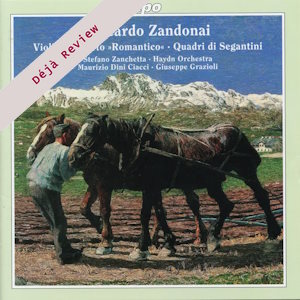
Déjà Review: this review was first published in August 2005 and the recording is still available.
Riccardo Zandonai (1883-1944)
Violin Concerto ‘Romantico’ (1919)
Quadri di Segantini RZ 225 (1931)
Stefano Zanchetta (violin)
Orchestra Haydn di Bolzano e Trento/Maurizio Dini Ciacci, Giuseppe Grazioli
rec. 2000/03, Auditorium, Konzerthaus J Haydn, Bolzano, Italy
cpo 777107-2 [57]
Opera fanatics will certainly know the name of the Italian composer Riccardo Zandonai. He wrote about a dozen stage works so clearly here was a composer working to the national script when it came to music production. However there are occasional exceptions to this in his catalogue. Here are two.
Konrad Dryden provides the notes and is well placed to do so having written ‘Riccardo Zandonai – a Biography’ (Peter Lang, 1999). He tells us that the Violin Concerto was premiered after various vicissitudes on 30 January 1921 when the soloist was Remy Principe. Lyrical and euphonious writing predominates and the solo instrument sings in tones both direct and hooded. The drama – and there is some – is of the sort we find in the violin concertos of Dvořák and Tchaikovsky and in Sibelius in his Cantique mood. There are smoochily legato slidings and sidlings as well as Arabian evenings especially in the finale. Zandonai clearly has both a taste and gift for reflections on beauty which yet avoid the static musing of Delius. There are Paganinian fireworks too and zigeuner influences in the finale. This is clearly not the work of a modernist. The Zandonai concerto can now be added to the roll-call of delightful and chirpily vital concertos counted alongside Glazunov, Dvorak, Haydn Wood, Holbrooke, Moskowski and de Boeck.
The Quadri di Segantini were inspired by the impressionist paintings of Giovanni Segantini (1858-1899). With the Roman examples of Respighi in mind Zandonai felt confident about the project. The music is best characterised as an essay in folk-grandeur. There are some orchestral roughnesses here which are not found in the concerto. Think perhaps of Tchaikovsky’s Capriccio Italien, early Strauss tone poems, Ludolf Nielsen’s orchestral suites and Canteloube’s cantando orchestral manner. The pictures were premiered at Rome’s Augusteo on 4 January 1932.
I love the quietly sighing slide of the violins at 4:53 in the Aratura and the sepia-toned saxophone (6.23). Idillio has more of those impressionist sighs and Canteloube-like woodwind piping in a landscape in which Debussy’s faune would have found himself at home. There’s even a wind machine in the Ritorno movement evoking both Debussy (La Mer) and Ravel (Daphnis). Meriggio is playful and bright-eyed.
Colourful nationalist music atmospherically presented and standing in the lineage of Dvořák and Respighi.
Rob Barnett
Buying this recording via a link below generates revenue for MWI, which helps the site remain free



















